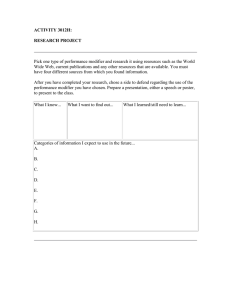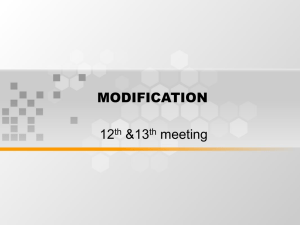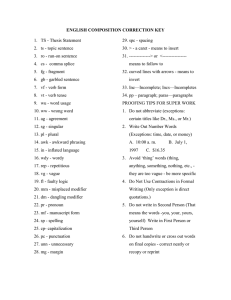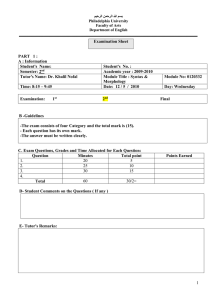Modifiers 25 and 59 - Santa Clara County Medical Association
advertisement
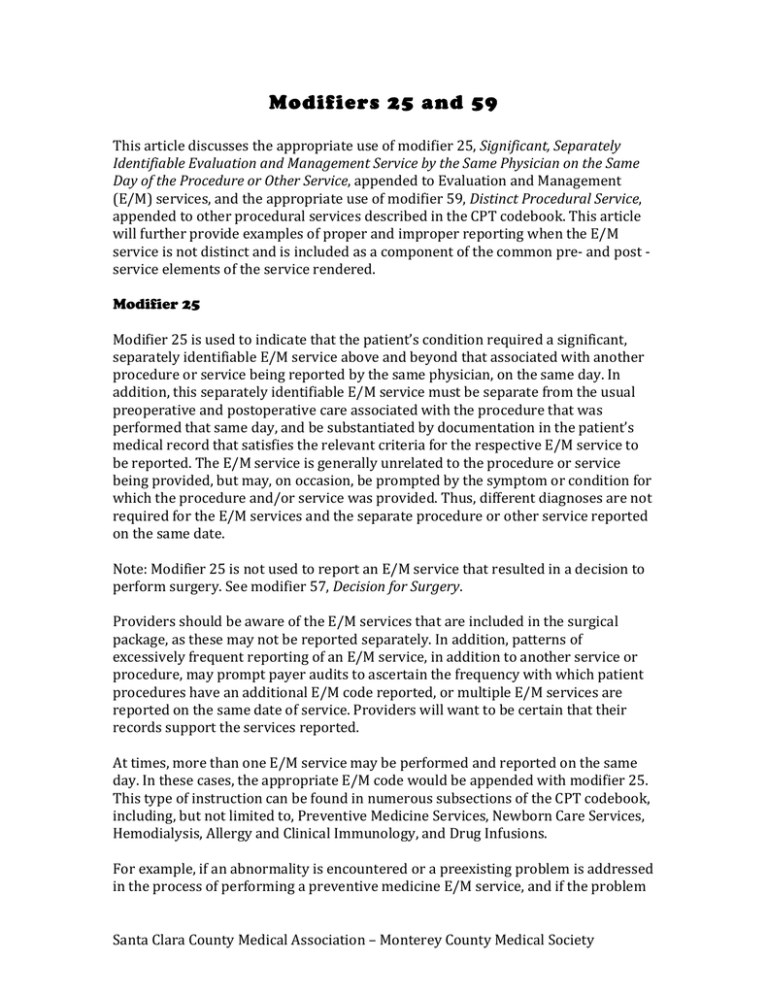
Modifiers 25 and 59 This article discusses the appropriate use of modifier 25, Significant, Separately Identifiable Evaluation and Management Service by the Same Physician on the Same Day of the Procedure or Other Service, appended to Evaluation and Management (E/M) services, and the appropriate use of modifier 59, Distinct Procedural Service, appended to other procedural services described in the CPT codebook. This article will further provide examples of proper and improper reporting when the E/M service is not distinct and is included as a component of the common pre-­‐ and post -­‐ service elements of the service rendered. Modifier 25 Modifier 25 is used to indicate that the patient’s condition required a significant, separately identifiable E/M service above and beyond that associated with another procedure or service being reported by the same physician, on the same day. In addition, this separately identifiable E/M service must be separate from the usual preoperative and postoperative care associated with the procedure that was performed that same day, and be substantiated by documentation in the patient’s medical record that satisfies the relevant criteria for the respective E/M service to be reported. The E/M service is generally unrelated to the procedure or service being provided, but may, on occasion, be prompted by the symptom or condition for which the procedure and/or service was provided. Thus, different diagnoses are not required for the E/M services and the separate procedure or other service reported on the same date. Note: Modifier 25 is not used to report an E/M service that resulted in a decision to perform surgery. See modifier 57, Decision for Surgery. Providers should be aware of the E/M services that are included in the surgical package, as these may not be reported separately. In addition, patterns of excessively frequent reporting of an E/M service, in addition to another service or procedure, may prompt payer audits to ascertain the frequency with which patient procedures have an additional E/M code reported, or multiple E/M services are reported on the same date of service. Providers will want to be certain that their records support the services reported. At times, more than one E/M service may be performed and reported on the same day. In these cases, the appropriate E/M code would be appended with modifier 25. This type of instruction can be found in numerous subsections of the CPT codebook, including, but not limited to, Preventive Medicine Services, Newborn Care Services, Hemodialysis, Allergy and Clinical Immunology, and Drug Infusions. For example, if an abnormality is encountered or a preexisting problem is addressed in the process of performing a preventive medicine E/M service, and if the problem Santa Clara County Medical Association – Monterey County Medical Society or abnormality is significant enough to require additional work to perform the key components of a problem-­‐oriented E/M service, then the appropriate Office or Other Outpatient code (99201-­‐99215) may be reported, in addition to the preventive medicine E/M service. Modifier 25 should be added to the Office or Other Outpatient E/M code to indicate that a significant, separately identifiable E/M service, was provided by the same physician, on the same day, as the preventive medicine service. (See Example A). An insignificant or trivial problem/abnormality that is encountered in the process of performing the preventive medicine E/M service that does not require additional work and the performance of the key components of a problem-­‐oriented E/M service should not be reported separately. Example A A 45-­‐year-­‐old male visited his family physician for his annual check-­‐up. The physician performed and documented a comprehensive review of systems along with his medical, family, and social history. A comprehensive multisystem examination was performed. Counseling on diet, exercise, and prevention was provided, and appropriate laboratory tests were ordered. During the encounter, the patient complained of bilateral knee pain with tenderness and swelling. The physician found, during the examination, that both knees were swollen. Additional history was obtained, the knees were further examined, and the patient was then given a prescription for a nonsteroidal anti-­‐inflammmatory drug and was asked to return in two weeks. How to Report 99396 Periodic comprehensive preventive medicine re-­‐evaluation and management of an individual including an age and gender appropriate history, examination, counseling/anticipatory guidance/risk factor reduction interventions, and the ordering of laboratory/diagnostic procedures, established patient; 40-­‐ 64 years. 99212-­‐25 Office or other outpatient visit for the evaluation and management of an established patient, which requires at least two of these three key components: a problem focused history; a problem focused examination; straightforward medical decision-­‐making. Rationale for Using Modifier 25 Extra physician work was required to obtain the history and evaluate the knee problem. It would be appropriate to report both the preventive and problem-­‐ focused E/M codes for the same visit with modifier 25 appended. The level of the problem-­‐focused service is based on the amount of additional work the physician provided. Santa Clara County Medical Association – Monterey County Medical Society CPT Guidelines and Use of Modifier 25 Modifier 25 should be used with E/M codes only. Modifier 25 is not restricted to a specific level of E/M service. The E/M service must meet the key components of that code. CPT guidelines do not require different diagnoses in order for an E/M service and the procedure or service performed to be reported separately. Modifier 25 should not be used to report an E/M service that results in a decision to perform surgery. Modifier 25 should only be used when the E/M service is significantly and separately identifiable from the procedure or other service performed on the same date. The E/M services provided must be properly documented in the medical record. Common Overlapping Services Between E/M and Other Services E/M services and other services may have many pre-­‐ and post-­‐service components in common. Therefore, modifier 25 is necessary to allow separate reporting of E/M services in addition to other services. Common overlapping services include the following: Review chart Greet patient Review results of progress since last visit Provide order based on progress Confirm order Provide follow-­‐up instructions to patient Complete chart documentation Proper Use of Modifier 25 Example 1 A patient presents with a fever, headache, vomiting, and a stiff neck. The physician obtains a history, performs a physical exam, and satisfies the requirements described with E/M code 99214 and then proceeds to perform a spinal tap. How to Report To report this patient encounter, the physician appends modifier 25 to E/M code 99214 and separately reports code 62270, Spinal puncture, lumbar, diagnostic. Santa Clara County Medical Association – Monterey County Medical Society Rationale Modifier 25 indicates that both a significant E/M service and procedure were performed on the same day. The spinal tap procedure is a separately identifiable procedure from the E/M service of performing a detailed history, examination, and moderate complexity decision making of the patient with regard to their fever, headache, vomiting, and stiff neck. Example 2 An established patient presented to his family physician’s office with a 2.0 cm laceration of his right index finger. After the physician sutured the finger, the patient asked the physician to evaluate swelling of his left leg and ankle. An expanded, problem-­‐focused history and physical examination with low complexity medical decision making were performed. How to Report The evaluation of the laceration is considered inclusive of the preoperative evaluation and is included in surgical procedure code 12001. For the evaluation of the patient’s left leg and ankle, code 99213 would be separately reported with modifier 25 appended. The appropriate diagnosis codes would be appended to each service reported. Rationale The patient presented to the physician with two problems that were separately identifiable and significant: the swelling of the left leg and ankle and a finger laceration. A surgical procedure and a separate E/M service were performed and documented. Improper Use of Modifier 25 Example 1 A patient complained of left knee pain. At a previous visit, the physician evaluated the knee, ordered a prescription of a nonsteroidal anti-­‐inflammatory drug and scheduled a follow-­‐up visit for two weeks later for performance of an arthrocentesis, if not improved. The patient returned, wherein the physician performed an arthrocentesis and injection of the left knee joint and scheduled a follow-­‐up visit for one month later. Rationale for Not Using Modifier 25 It would not be appropriate to report the E/M service at the two-­‐week follow-­‐up visit because the focus of the visit was related to the performance of an arthrocentesis. Only code 20610 for the arthrocentesis would be reported. Santa Clara County Medical Association – Monterey County Medical Society Example 2 Ms. Smith scheduled an appointment to have a lesion removed from her right leg. The physician looked at the lesion, which appeared benign, and infiltrated the lesion with 1% lidocaine. The lesion was removed and a simple closure was performed. The lesion measured 1.0 cm in diameter, including margins. The physician sent the specimen to pathology, and the report indicated the lesion was benign. Rationale for Not Using Modifier 25 The patient’s sole purpose for the visit was lesion removal and the examination was limited to evaluating the lesion and deciding to remove it. Therefore, it would not be appropriate to report an E/M service in addition to the procedure. The evaluation before removing the lesion is considered part of the preoperative work-­‐up and is not significantly and separately identifiable. Modifier 25 Usage Checklist When determining whether to append modifier 25 to an E/M service, address the following questions: 1. Was the physician’s evaluation and management of the problem significant and beyond the normal preoperative and postoperative work? If yes, then an E/M service may be reported with modifier 25 appended. If not, it is not appropriate to report an E/M service with modifier 25 appended, as the service is included as part of the surgical package. 2. Was the procedure or service scheduled before the patient encounter? If yes, then it would not be medically necessary to report an E/M service, unless the patient had other concerns or problems that were addressed during the same encounter. Coding Tip: Although this reporting method reflects the intent of CPT and the Centers for Medicare and Medicaid Services (CMS), other third-­‐party payers may have different policies regarding the use of modifiers 25 and 59, and may request these services be reported differently. Santa Clara County Medical Association – Monterey County Medical Society Definition of Surgical Package As listed in the CPT Surgical Package Definition located in the Surgery guidelines of the CPT codebook, subsequent to the decision for surgery, one related E/M encounter on the date immediately prior to or on the date of procedure (including history and physical) is included in a given CPT surgical code. Also included in the surgical package is the immediate postoperative care, including dictating operative notes, talking with the family and other physicians, writing orders, evaluating the patient in the postanesthesia recovery area, as well as typical postoperative follow-­‐ up care. Modifier 59 Under certain circumstances, it may be necessary to perform a procedure or service that is distinct or independent from other non-­‐E/M services performed on the same day. Modifier 59, Distinct Procedural Service, is used to identify such procedures/services, other than E/M services, that are not usually reported together, but are appropriate under the circumstances. Documentation should support a different session, different procedure or surgery, different site or organ system, separate incision/excision, separate lesion, or separate injury (or area of injury in extensive injuries) not ordinarily encountered or performed on the same day, by the same individual. However, when another already established modifier is appropriate, it should be used rather than modifier 59. Modifier 59 may be reported only if no modifier that is more descriptive is available, and if the use of modifier 59 best explains the circumstances. Note: Modifier 59 should not be appended to an E/M service. To report a separate and distinct E/M service with a non-­‐E/M service performed on the same date, modifier 25 is used. Some codes in the CPT code set have been identified with the term, separate procedure, in the code descriptor. Modifier 59 is also intended to assist in the reporting of codes with the separate procedure designation. When a procedure or service that is designated as a separate procedure is carried out independently, considered unrelated or distinct from other procedures or services provided at that time, that procedure may be reported by itself or in addition to other procedures or services by appending modifier 59 to the specific separate procedural code reported. This indicates that the procedure is not considered a component of the other procedure, but is a distinct, separate procedure such as involving a different site or organ system, a separate incision or excision, a separate lesion, treatment of a separate injury (or area of injury in extensive injuries), or performed at a different session. Codes designated as separate procedures may not be additionally reported when the procedure or service is performed as an integral component of another procedure or service. Santa Clara County Medical Association – Monterey County Medical Society Proper Use of Modifier 59 Example 1 A malignant lesion with an excised diameter of 1.5 cm is excised from the left arm, and another malignant lesion with an excised diameter of 2.0 cm is excised from the right arm. How to Report As indicated in the Integumentary System Excision-­‐Malignant Lesions guidelines, each malignant lesion excised should be reported separately. The appropriate method of reporting the excision of the malignant lesion from the left arm with an excised diameter of 1.5 cm and the excision of the malignant lesion from the right arm with an excised diameter of 2.0 cm would be with code 11602, Excision, malignant lesion including margins, trunk, arms, or legs; excised diameter 1.1 to 2.0 cm, reported twice with modifier 59 appended to the second code. Rationale Modifier 59 would be appended to the second code to indicate that a distinct procedure was performed on a different anatomical site. Based on payer requirements, the HCPCS Level II-­‐RT or –LT modifiers may be required. Modifier 59 With Global Modifiers 58 and 79 Example 2 A patient had a 1.5-­‐cm malignant lesion excised from his leg at a previous operative session. Subsequently, during the postoperative period, a residual tumor was noted at the margin of the original excision and the margins were re-­‐excised. The re-­‐ excision included a 1.0 cm excised diameter. During the same visit, the physician noted another lesion on the patient’s foot that appeared to be benign. This lesion measured 1.5 cm in diameter, including the margins. The lesion was removed, and a simple closure was performed. The pathology report indicated the lesion was benign. How to Report 11601-­‐58 Excision, malignant lesion including margins, trunk, arms, or legs; excised diameter 0.6 to 1.0 cm 11422-­‐79-­‐59 Excision, benign lesion including margins, except skin tag (unless listed elsewhere), scalp, neck, hands, feet, genitalia; excised diameter 1.1 to 2.0 cm Santa Clara County Medical Association – Monterey County Medical Society Rationale The re-­‐excision procedure performed to widen margins at a subsequent operative session is reported using the appropriate code (11601) that identifies the size, location, and type of excision performed with modifier 58, appended. Because the benign lesion on the foot removed at that same session was during a postoperative global period, modifier 79 should be appended in order for the physician to indicate that the performance of a procedure or service during the postoperative period was unrelated to the original procedure, along with modifier 59 to indicate that it is a separate procedure unrelated to the one performed during the postoperative session. Commonly Asked Questions Question: When reporting one E/M service (99213) and one procedure (17000), which code gets the modifier? Is modifier 25 appended to the E/M service and modifier 59 appended to the procedure code? Answer: Only the E/M service would have modifier 25 appended to show that the E/M service provided is above and beyond the usual E/M service associated with that procedure. The procedure would not have a modifier appended in the scenario. Question: If the patient returns to the office during the postoperative period for a related procedure and also has a problem-­‐focused E/M service for a different reason, how is this reported? Is it appropriate to append modifier 58 to the procedure and also append modifier 25 to the E/M service to indicate that it was a separate E/M service? Answer: No. Modifier 25 would not be appended to the E/M code. In this case, because the E/M service is unrelated to the procedure performed during the global period, the E/M service would be appended with modifier 24, unrelated evaluation and management service by the same physician during a postoperative period. Modifier 58 would be appended to the related procedure performed during the postoperative period. Source: CPT Assistant – March 2012 Santa Clara County Medical Association – Monterey County Medical Society
